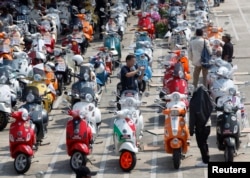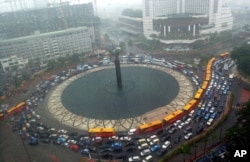The World Health Organization (WHO) is pressing Asian countries to cut their road death and injury toll in half by 2020.
A 2015 study from Chalmers Technical University in Goteborg, Sweden, covering 24 Asian countries encompassing 56 percent of the world's population, says the total highway death toll for those countries is 750,000 per year with traffic accidents the leading cause of death for people under the age of 30.
The study says the injury toll is more than 50 million, of which 12 percent are hospital admissions, leading to economic costs of around $800 billion or 3.6 percent of the gross domestic product in those 24 countries.
Steep rise in traffic deaths in Thailand
Thailand, which recently marked the traditional Thai New Year celebrations, has reported a 30 percent rise in its road death toll for the holiday period, rising to a record of more than 400 people killed.
Thai officials say speeding is the leading cause of accidents, along with drink driving, with most accidents – some 80 percent – involving motorcycles. Public Health Ministry officials put the injury toll at more than 25,000 people, with more than 3,200 of those seriously hurt requiring hospital treatment.
The toll came despite a blitz by Thai police, reportedly arresting more than 110,000 people and impounding 5,700 vehicles at road safety checkpoints across the country.
Nana Soetantri, a transport specialist with the Asian Development Bank (ADB), said the toll in Thailand is grim news, and on a per capita basis exceeds most other countries in the region.
“It’s unfortunate but Thailand – among ADB developing member countries – is on the top. Their estimated traffic deaths per 100,000 of population is about 36.2 and it’s higher than Vietnam and higher than China,” Soetantri told VOA.
“I understand that in Thailand the rate of motorization is actually greater than the other countries in the ASEAN [Association of South East Asian Nations] as well,” she said.
Offenders sent to work in hospital morgues
Thai police, in a bid to shock drivers into greater road safety, say traffic offenders will face community service work at hospital morgues.
But the English language newspaper The Bangkok Post, in a weekend editorial, said the government’s road safety strategy was falling short, questioning the plan of sending people to work in morgues – a program the paper says was adopted and dropped a decade earlier.
High motorcycle death rate
The paper said motorcyclist deaths were a disproportionate number in the toll, with drunk drivers and lax attitudes towards safety helmets and seat belts also contributing factors.
The ADB’s Soetantri, while welcoming the Thai authorities’ tougher measures, said concrete knowledge was necessary if road safety policies were to be effective.
“What they’re trying to do with arresting these people – it’s commendable to some degree. But one needs to question; what is the science behind it? Because if they are targeting drink drivers- are drink drivers the main factors of death in the traffic injuries in Thailand?” she said.
Jac Wismans, a university engineer lecturer at Chalmers Technical University in Sweden, said the rapid rise in motorization in developing countries is the prime reason for the rising death and injury toll.
But Wismans, a co-author of the 2015 research report on the status of road safety in Asia, said the dramatic increase is already leading countries to take action in a bid to stem the toll.
Some reduction in deaths in recent years
WHO data shows that since 2004, China, with an annual road death toll of around 261,300, has seen a steady decline in reported deaths per 100,000 of people through safer road networks, enforcing drunk driving laws, as well as enforcing seat belt wearing laws.
In Vietnam, where motorcycles comprise some 95 per cent of all registered vehicles, there will be tougher enforcement of laws requiring drivers and passengers to wear helmets. Police reports indicated over 1,500 lives were saved and 2,500 serious injuries prevented.
“Since the last five, almost 10 years, the total number of fatalities and injuries has stabilized [globally]. Where it is reducing is in the U.S., and Europe and Japan and it’s still increasing in developing countries,” said Wismans.
“But the aim of the World Health Organization (WHO) is it’s possible soon, with all the measures in force, to see a reduction in accidents and injuries taking place in developing countries,” he said.
The WHO said without policy action to lower the toll, road traffic accidents would be expected to account for around 1.9 million deaths annually across the world by 2020.
The United Nation’s Global Plan for the “Decade of Action for Road Safety from 2011-2020” is aimed at cutting the forecasted level of fatalities around the world in half, saving as many as five million lives.









